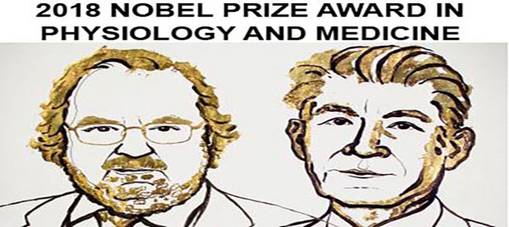
Immune checkpoints: brakes of the immune system
Pubblicato il: 10.12.2018 10:49
In the day of the Nobel Prize Award ceremony, our Department would like to highlight Award in Physiology and Medicine to James P. Allison and Tasuku Honjo for their amazing discoveries which laid the foundations for the development of cancer immunotherapy.
The maintenance of the homeostasis of the immune system is crucial for host survival. Exacerbated immune responses to pathogens or self-antigens can cause tissue damage and autoimmune diseases. To avoid the triggering of an uncontrolled response, the immune system requires a fine tuning to maintain the equilibrium. The signals responsible for controlling this mechanism are the so-called immune checkpoints, which are necessary for maintaining self-tolerance and protecting the host from tissue damage. The field of cancer immunotherapy has made significant steps forward over the past decade, prompted by the enhanced understanding of the complex relationship between the tumor and the immune system and the lack of immunologic control is currently recognized as one of the emerging hallmarks of cancer.
The concept of cancer immunotherapy goes back in 1891 when a young New York surgeon named William Coley began intra-tumoral injections of bacterial products and observed tumor reduction in patients with sarcoma. After one century in the 1990s, two scientists, Allison (in Berkley, California) and Honjo (in Kyoto Japan), were conducting their pioneering research.
Allison’s laboratory, as other research teams, was studying the suppressive role of CTLA-4, a protein expressed on T lymphocytes, demonstrating that it acts as a brake on T cells. Allison developed an antibody that binds CTLA-4 with the idea to remove the inhibitory signals of T lymphocytes activation. He demonstrated that the release of the brake allows T lymphocytes to attack tumor cells.
In the same period, from the other side of the ocean, Honjo’s research group discovered the protein PD-1, a molecule expressed on the surface of T lymphocytes. He performed extraordinary experiments demonstrating that PD-1 acts as a cellular brake on T lymphocytes, similar to the protein CTLA-4 but with a different mechanism of action. The blockade of PD-1 clearly demonstrated to be a powerful strategy to counteract cancer growth: T lymphocytes brake is released, and these cells are able to attack and kill tumor cells.
Nowadays the immunotherapy based on immune checkpoint blockade is constantly evolving, and its application for cancer treatment has dramatically changed the clinical outcome for a certain group of patients with advanced cancer. Since Allison’s discovery, several groups dedicated many efforts to study the role of CTLA-4 as an immune checkpoint, and from clinical studies emerged the enormous therapeutic potential of drugs blocking CTLA-4 in many types of cancer, particularly melanoma. Finally, Allison’s research was translated to clinical practice, when in 2011 Food and Drug Administration (FDA) approved the use of Ipilimumab, a human monoclonal antibody that can bind CTLA-4, to treat advanced and metastatic melanoma, producing durable anti-tumor responses and prolonged survival in patients. Likewise, several monoclonal antibodies able to inhibit PD-1 function have been developed and are now in clinical trials for melanoma and non-small cell lung carcinoma (NSCLC): Nivolumab, Pembrolizumab and Pidilizumab. Importantly, the most promising results with patients were obtained by the combination treatment of Ipilimumab and Nivolumab. Nevertheless, there is a still a great work needed to clarify the fundamental mechanism and predictive biomarkers for the efficacy and adverse effects of this therapeutic strategy.
Allison and Honjo, with their discoveries, paved the way to a new frontier of cancer therapy, that in combination with classical treatments (chemotherapy, radiotherapy) increase the success rate in fighting tumors.Checkpoint therapy has revolutionized cancer treatment over the past decade making an outstanding journey from the bench to the bedside, so fundamentally changing the way we view how cancer can be managed.





